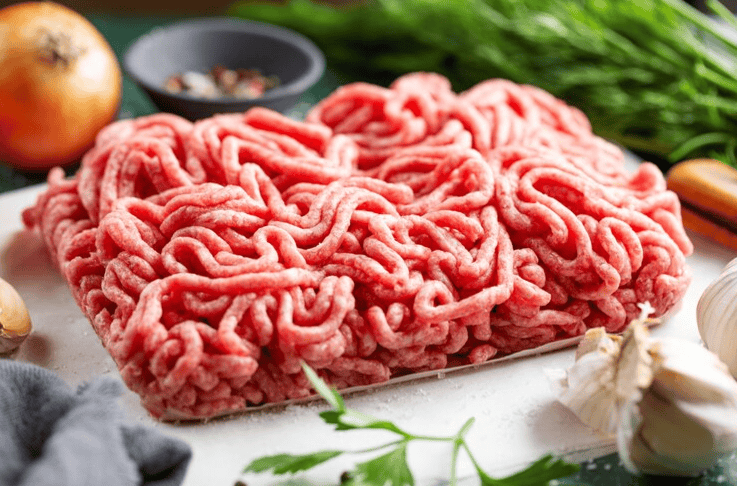Beef mince, also known as ground beef, is a versatile and widely used ingredient in many cuisines. From homemade burgers to pasta sauces and meatballs, it’s a staple in countless meals. But when it comes to health, is beef mince a nutritious choice, or should it be consumed in moderation?
This article explores the nutritional profile of beef mince, its potential health benefits, and concerns such as fat content and processing. We’ll also discuss the best ways to cook and enjoy beef mince as part of a balanced diet. Whether you’re looking to build muscle, maintain a healthy weight, or reduce your saturated fat intake, understanding how beef mince fits into your diet is essential.
Read on to discover if beef mince is a healthy choice and how to make smarter decisions when purchasing and preparing it.
Nutritional Profile of Beef Mince
Beef mince is a rich source of protein, essential vitamins, and minerals, making it a valuable component of a balanced diet. However, its nutritional value varies depending on the fat content and how it is prepared.
Macronutrient Breakdown (Per 100g Serving of Cooked Beef Mince)
| Nutrient | Lean (5% Fat) | Regular (15% Fat) | High-Fat (20% Fat) |
|---|---|---|---|
| Calories | 137 kcal | 215 kcal | 250 kcal |
| Protein | 22g | 19g | 17g |
| Total Fat | 5g | 15g | 20g |
| Saturated Fat | 2g | 6g | 8g |
| Carbohydrates | 0g | 0g | 0g |
| Iron | 2.3mg (13% DV) | 2.2mg (12% DV) | 2.1mg (12% DV) |
| Vitamin B12 | 2.4mcg (100% DV) | 2.3mcg (96% DV) | 2.2mcg (92% DV) |
Key Micronutrients in Beef Mince:
- Iron: Supports oxygen transport in the blood, preventing anemia.
- Vitamin B12: Crucial for brain function and red blood cell production.
- Zinc: Strengthens the immune system and supports metabolism.
Comparison with Other Protein Sources
- Chicken breast (100g): ~165 kcal, 31g protein, 3.6g fat.
- Turkey mince (100g): ~135 kcal, 22g protein, 3g fat.
- Lentils (100g cooked): ~116 kcal, 9g protein, 0.4g fat, 20g carbs.
Compared to poultry and plant-based options, lean beef mince provides high-quality protein and essential nutrients but tends to be higher in saturated fat. Choosing leaner cuts and cooking methods can help maximize the benefits while minimizing health risks.
Health Benefits of Beef Mince
Beef mince is a nutrient-dense protein source that provides essential vitamins and minerals, making it a valuable addition to a balanced diet when consumed in moderation.
High-Quality Protein for Muscle Growth and Satiety
Beef mince is an excellent source of complete protein, containing all nine essential amino acids.
- Muscle Growth & Recovery: Protein is crucial for muscle repair and development, making beef mince a great choice for athletes and active individuals.
- Satiety & Weight Management: High-protein meals can promote fullness and reduce cravings, which may help with weight control.
Iron and Vitamin B12 for Energy and Red Blood Cell Production
- Iron: Beef mince is rich in heme iron, the most bioavailable form, which helps prevent iron-deficiency anemia and supports oxygen transport in the blood.
- Vitamin B12: Essential for brain function, DNA production, and red blood cell formation, a deficiency in B12 can lead to fatigue and neurological issues.
Zinc and Other Nutrients for Immune Support
- Zinc: Plays a vital role in immune function, wound healing, and metabolism.
- Selenium: Acts as an antioxidant, supporting thyroid health and reducing inflammation.
Lean vs. Fatty Mince: Heart Health Considerations
- Lean beef mince (5% fat): Lower in saturated fat and calories, making it a heart-friendlier choice for those watching cholesterol levels.
- Higher-fat mince (15–20% fat): Contains more saturated fat, which, when consumed in excess, may contribute to high cholesterol and heart disease risk.
Beef mince provides high-quality protein, iron, and essential nutrients, supporting muscle growth, energy levels, and immune health. Opting for leaner cuts can help maximize the benefits while reducing potential health risks.

Potential Health Concerns of Beef Mince
While beef mince is a nutrient-rich protein source, certain health concerns should be considered when consuming it regularly.
Saturated Fat and Heart Health Concerns
- Higher-fat beef mince (15–20% fat) contains significant amounts of saturated fat, which may contribute to increased LDL (“bad”) cholesterol levels when consumed in excess.
- Diets high in saturated fat have been linked to an increased risk of heart disease.
- Opting for lean mince (5–10% fat) can help reduce saturated fat intake while still providing essential nutrients.
Cholesterol Impact—Does Beef Mince Raise Bad Cholesterol?
- Saturated fat in fatty cuts of beef mince may lead to higher LDL cholesterol, which is associated with arterial plaque buildup.
- However, lean beef mince in moderation can be part of a heart-healthy diet, especially when balanced with fiber-rich foods like vegetables and whole grains.
Processed vs. Fresh Beef Mince—Avoiding Additives and Preservatives
- Pre-packaged or processed beef mince (such as frozen patties) may contain preservatives, sodium, and fillers, which can negatively impact health.
- Fresh, unprocessed beef mince with minimal additives is the healthier option.
Cooking Methods and Cancer Risks
- Cooking beef mince at high temperatures (grilling, frying, charring) can produce harmful compounds like heterocyclic amines (HCAs) and polycyclic aromatic hydrocarbons (PAHs), which have been linked to cancer risk.
- Healthier cooking methods, such as boiling, steaming, or slow-cooking, reduce the formation of these compounds.
To minimize health risks, choose lean, fresh beef mince, avoid processed varieties, and use healthier cooking methods like boiling or slow-cooking instead of grilling or frying.
Choosing and Cooking Beef Mince Healthily
Beef mince is a versatile and nutritious protein source, but the way you choose and prepare it significantly impacts its health benefits.
Lean vs. Fatty Mince—What’s the Healthiest Choice?
- Lean beef mince (90% lean, 10% fat or higher) is the best option for reducing saturated fat intake while still getting high-quality protein, iron, and B vitamins.
- Higher-fat beef mince (70–80% lean, 20–30% fat) contains more flavor but also higher amounts of saturated fat and calories, which can contribute to heart disease and weight gain when consumed in excess.
- Draining excess fat after cooking can help reduce overall fat intake.
Best Cooking Methods for Healthier Beef Mince
Cooking method plays a crucial role in how healthy beef mince is:
- Boiling – One of the healthiest ways to cook beef mince as it removes excess fat.
- Baking – A great hands-off method that retains nutrients while minimizing added fats.
- Grilling/Broiling – Helps reduce excess fat but can produce harmful compounds if overcooked.
- Stir-frying – A quick and healthy method if using minimal oil and plenty of vegetables.
- Frying – Least healthy option, as it increases fat content, especially if using unhealthy oils.
Healthy Beef Mince Recipes
Incorporate beef mince into nutritious meals:
- Beef Mince Stir-Fry – Cook with garlic, ginger, and mixed vegetables for a nutrient-packed dish.
- Healthy Chili – Use lean beef, beans, tomatoes, and spices for a fiber-rich, high-protein meal.
- Lettuce Wraps – Swap tortillas for crisp lettuce leaves and season lean beef mince with herbs and spices.
By choosing lean beef mince and using healthier cooking methods, you can enjoy its benefits while maintaining a balanced diet.

Beef Mince vs. Other Proteins: Which Is the Healthiest Choice?
Beef mince is a popular protein source, but how does it compare to alternatives like chicken, turkey, and plant-based options?
Beef Mince vs. Chicken Mince
- Protein Content: Both are high in protein, but chicken mince is typically leaner, with less saturated fat.
- Fat and Calories: Chicken mince (especially breast meat) is lower in calories and fat compared to regular beef mince.
- Heart Health: Lean chicken is often a better choice for those watching their cholesterol and heart health.
Beef Mince vs. Turkey Mince
- Lean turkey mince (93% lean or higher) is lower in saturated fat than beef mince while still providing plenty of protein.
- Fatty turkey mince (85% lean or lower) has a similar fat content to regular beef mince.
- Turkey is generally better for heart health, but lean beef is still a nutrient-dense option.
Beef Mince vs. Plant-Based Alternatives
- Lentils, tofu, and tempeh are great plant-based protein options with zero cholesterol and more fiber than beef mince.
- Soy-based meat substitutes can be a good alternative, but some may contain additives or excessive sodium.
Best Protein for Weight Loss and Heart Health
- Lean poultry and plant-based proteins are best for heart health due to lower saturated fat levels.
- For weight loss, all options can work if consumed in moderation, but lean meats and plant-based proteins tend to be lower in calories.
Ultimately, lean beef mince can be part of a balanced diet, but chicken, turkey, and plant-based options may be better choices for heart health and weight management.
FAQs About Beef Mince
Is Beef Mince Good for Weight Loss?
Yes, lean beef mince can be a good option for weight loss as it is high in protein, which promotes satiety and helps preserve muscle mass. However, regular beef mince with higher fat content can add excess calories, so choosing 90% lean or higher is best for weight management.
How Often Should You Eat Beef Mince?
Moderation is key. Consuming lean beef mince 2–3 times per week as part of a balanced diet can provide essential nutrients like protein, iron, and B12. However, excessive red meat intake has been linked to certain health risks, so variety in protein sources is recommended.
Does Beef Mince Have Too Much Fat?
Regular beef mince can be high in saturated fat, which may contribute to heart disease if consumed in excess. Lean or extra-lean beef mince (90% or higher) contains significantly less fat, making it a healthier option.
Is Lean Beef Mince Healthier Than Regular Mince?
Yes, lean beef mince has less saturated fat and fewer calories while still being rich in protein, iron, and essential vitamins. Choosing leaner cuts (90% lean or higher) supports heart health and weight management.
What Are the Healthiest Ways to Cook Beef Mince?
The best cooking methods include:
- Grilling or baking to allow excess fat to drain off.
- Boiling as a low-fat option for soups or stews.
- Stir-frying with vegetables for added nutrients and fiber.
- Avoiding deep frying or excessive oil use to keep it healthier.
By choosing leaner cuts and healthy cooking methods, beef mince can be a nutritious addition to your diet.
Conclusion
Beef mince can be a nutritious and versatile protein source, offering high-quality protein, iron, B12, and zinc—all essential for muscle growth, energy production, and immune function. However, its health impact depends on the type and preparation method.
Lean beef mince (90% lean or higher) is a better option for those looking to manage weight, heart health, and cholesterol levels, as it contains less saturated fat. Cooking methods such as grilling, baking, or boiling help retain nutrients while reducing excess fat intake.
While beef mince can be part of a healthy diet, moderation is key. Excessive consumption of red meat, particularly processed varieties, has been linked to health risks. Balancing beef mince with lean poultry, fish, plant-based proteins, and fiber-rich foods ensures a well-rounded diet.
By making smart choices with lean cuts and healthy cooking techniques, beef mince can be a beneficial addition to a nutritious meal plan.


